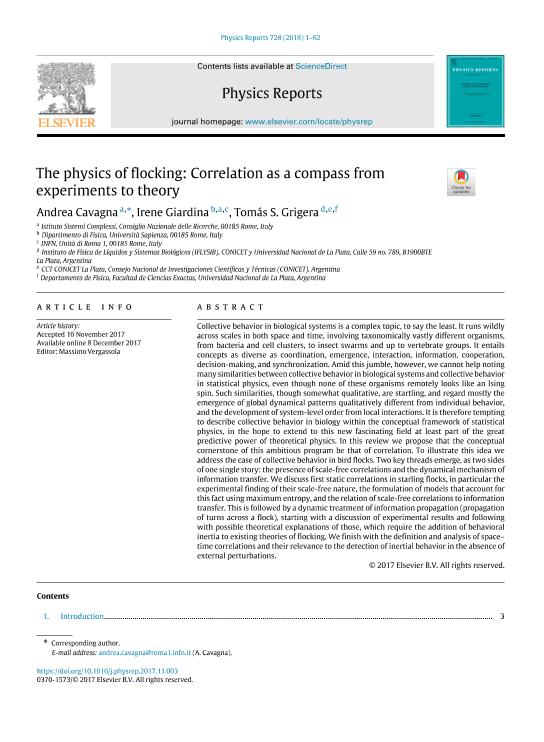Mostrar el registro sencillo del ítem
dc.contributor.author
Cavagna, Andrea
dc.contributor.author
Giardina, Irene
dc.contributor.author
Grigera, Tomas Sebastian

dc.date.available
2019-11-27T17:39:43Z
dc.date.issued
2018-01
dc.identifier.citation
Cavagna, Andrea; Giardina, Irene; Grigera, Tomas Sebastian; The physics of flocking: Correlation as a compass from experiments to theory; Elsevier Science; Physics Reports-review Section Of Physics Letters; 728; 1-2018; 1-625
dc.identifier.issn
0370-1573
dc.identifier.uri
http://hdl.handle.net/11336/90665
dc.description.abstract
Collective behavior in biological systems is a complex topic, to say the least. It runs wildly across scales in both space and time, involving taxonomically vastly different organisms, from bacteria and cell clusters, to insect swarms and up to vertebrate groups. It entails concepts as diverse as coordination, emergence, interaction, information, cooperation, decision-making, and synchronization. Amid this jumble, however, we cannot help noting many similarities between collective behavior in biological systems and collective behavior in statistical physics, even though none of these organisms remotely looks like an Ising spin. Such similarities, though somewhat qualitative, are startling, and regard mostly the emergence of global dynamical patterns qualitatively different from individual behavior, and the development of system-level order from local interactions. It is therefore tempting to describe collective behavior in biology within the conceptual framework of statistical physics, in the hope to extend to this new fascinating field at least part of the great predictive power of theoretical physics. In this review we propose that the conceptual cornerstone of this ambitious program be that of correlation. To illustrate this idea we address the case of collective behavior in bird flocks. Two key threads emerge, as two sides of one single story: the presence of scale-free correlations and the dynamical mechanism of information transfer. We discuss first static correlations in starling flocks, in particular the experimental finding of their scale-free nature, the formulation of models that account for this fact using maximum entropy, and the relation of scale-free correlations to information transfer. This is followed by a dynamic treatment of information propagation (propagation of turns across a flock), starting with a discussion of experimental results and following with possible theoretical explanations of those, which require the addition of behavioral inertia to existing theories of flocking. We finish with the definition and analysis of space-time correlations and their relevance to the detection of inertial behavior in the absence of external perturbations.
dc.format
application/pdf
dc.language.iso
eng
dc.publisher
Elsevier Science

dc.rights
info:eu-repo/semantics/openAccess
dc.rights.uri
https://creativecommons.org/licenses/by-nc-sa/2.5/ar/
dc.subject
Flocking
dc.subject
Correlations
dc.subject
Collective motion
dc.subject.classification
Biofísica

dc.subject.classification
Ciencias Biológicas

dc.subject.classification
CIENCIAS NATURALES Y EXACTAS

dc.title
The physics of flocking: Correlation as a compass from experiments to theory
dc.type
info:eu-repo/semantics/article
dc.type
info:ar-repo/semantics/artículo
dc.type
info:eu-repo/semantics/publishedVersion
dc.date.updated
2019-10-17T20:14:20Z
dc.journal.volume
728
dc.journal.pagination
1-625
dc.journal.pais
Países Bajos

dc.description.fil
Fil: Cavagna, Andrea. Consiglio Nazionale delle Ricerche; Italia
dc.description.fil
Fil: Giardina, Irene. Instituto Nazionale de Física Nucleare Sezione Di Roma Tor Vergata; Italia
dc.description.fil
Fil: Grigera, Tomas Sebastian. Consejo Nacional de Investigaciones Científicas y Técnicas. Centro Científico Tecnológico Conicet - La Plata. Instituto de Física de Líquidos y Sistemas Biológicos. Universidad Nacional de La Plata. Facultad de Ciencias Exactas. Instituto de Física de Líquidos y Sistemas Biológicos; Argentina
dc.journal.title
Physics Reports-review Section Of Physics Letters

dc.relation.alternativeid
info:eu-repo/semantics/altIdentifier/doi/http://dx.doi.org/10.1016/j.physrep.2017.11.003
dc.relation.alternativeid
info:eu-repo/semantics/altIdentifier/url/https://www.sciencedirect.com/science/article/pii/S0370157317303575?via%3Dihub
Archivos asociados
